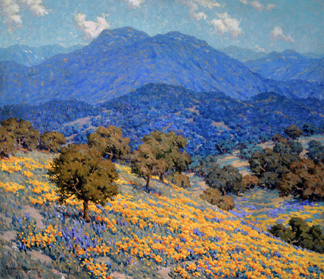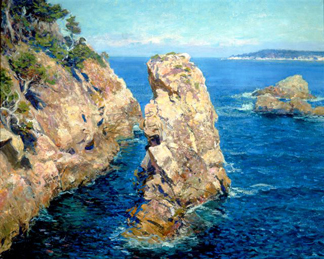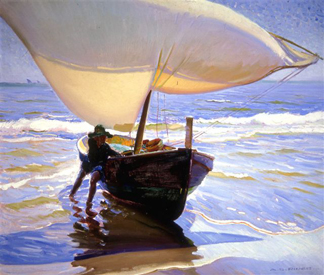
(845) 246-6944 ·
info@ArtTimesJournal.com
at Katonah Museum of Art
|
|
By RAYMOND J.
STEINER
September 2008
SOME TEN YEARS ago, Abbeville
Press published California Impressionists by William F. Gerdts and Will South, the book a standard
text on the subject for most of those years. What a treat to find that
Mr. Gerdts — along with Jean Stern of The Irvine Museum —
has curated a show* that has traveled east to the Katonah Museum of Art,
where we can now see at first hand a great many of the artists featured
in the Abbeville book. Some 60 works (fifty-nine paintings and one painted
vase) make up the exhibit, including five painters that were not included
in the earlier study.
There appears to be an irrepressible joie de vivre shared
by Impressionist painters — French or not — that is well-nigh
impossible for viewers to resist. Whether we will or no, the infectiousness
of dollops of light and color almost always overwhelm the senses, leaving
most viewers with a strong desire to lose themselves in these paintings
— or, more properly speaking, to discover their own particular vantage
point of observation — and this, in spite of the propensity to do
so, when some painters often make it manifestly unclear just where the
“imaginary viewer” is meant to “stand”.
Where, for example, are we to imagine ourselves in Alson
Skinner Clark’s The Weekend, Mission Beach, Meta Cressey’s
Under the Pepper Tree, or Sam Hyde Harris’s Todd Shipyards,
San Pedro? A mile away? On a balcony? Treading water?
 Granville Redmond, - Poppies and Lupines |
And does it really matter if you can feel yourself “in”
the picture or not? For this viewer, the powerful seduction of color has
always served as sort of an entrapment — a comforting “losing of
myself” that can cause me to overlook painterly faults — or at least
what I consider to be “faults”. Like Cézanne, I also believe that some
Impressionist-style painters — perhaps carried away by their obvious
immersion in the delights of nature — sometimes lose track of the
“cones and cylinders” that lend form to objects. Paintings such as Maurice
Braun’s San Diego Countryside with River, William Clapp’s
Country Road (which looks infinitely stronger in reproduction),
Frank Cuprien’s An Evening Symphony, John Frost’s The
Pool at Sundown, or Hanson Puthuff’s Monarch of the Malibu
all appear “washed out” in their sun-drenched atmospheres in comparison
to the drama of lights and darks found, for example, in Paul Dougherty’s
The Twisted Ledge, William F. Jackson’s Radiant Valley,
Edgar Payne’s High Sierra, or Granville Redmond’s Poppies
and Lupines.
This, of course, is all a matter of taste, and it may
just be my predilection for strong contrasts that blinds my eye to certain
“softer” (and soft-edged) tonal paintings. Truth be told, all of these
paintings are worthwhile seeing and we extend kudos to the Katonah Museum
of Art for hosting the show and bringing it into the New York area. Who
is so jaded not to be moved by the Impressionist vision — a veritable
reveling in color, light, and a Mother Nature that shields the eye from
harsh realities?
 Guy Rose, - Pt Lobos, 1918 |
Surely these plein-airistes invite us to flee the city,
to put on hiking boots in search of woodsy paths, hidden mountaintop meadows,
breathtaking vistas, out-of-the way ruins, small villages, and rocky shores.
So, enough carping! Go fill your eyes with “All Things
Bright & Beautiful” — New York aficionados of the Impressionist
Style will not want to miss this rare opportunity to see so many of these
wonderful works right here in our own backyard.
*“All
Things Bright & Beautiful: California Impressionist Paintings from
The Irvine Museum” (thru Oct 5): Katonah Museum of Art, 134 Jay St., Katonah,
NY (914) 232-9555. katonahmuseum.org. The exhibit will then travel
to The Hyde Collection, 161 Warren St., Glen Falls, NY (518) 792-1761
(Nov 16-Jan 8, ’09). hydecollection.org. A fully-illustrated catalogue of the same name
accompanies the exhibition.
 Arthur
G. Rider, - The Spanish Boat
Arthur
G. Rider, - The Spanish Boat